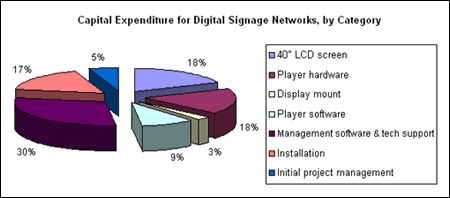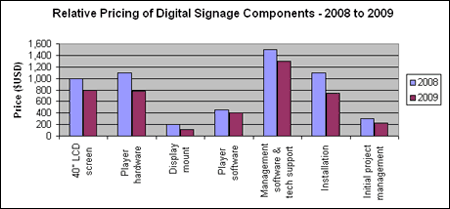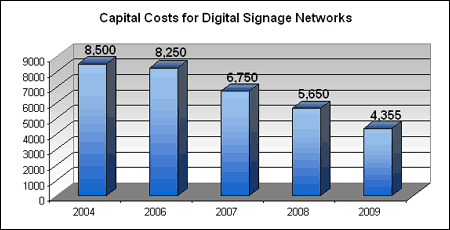A quick review and introduction
For those new to the market (and those who've read these articles before but have forgotten), the numbers below are meant to model a "typical" 100-screen network. What does that mean? I think this paragraph from last year's writeup still says it well:
While our previous cost estimates and ecosystem components have closely matched those from other industry analysts (so we don't think we're too far off the mark), the myth of a "typical" network is more strained this year than ever before. More vendors and network owners are choosing to implement screens with new formats and more varied locations, injecting more diversity into the projects. Plus, the idea that there's a standard staffing requirement for any digital signage network is pretty ridiculous. While we and others have proposed a list of key positions that need to be filled when creating a digital signage team, some networks are still very heavy on content production, while others might be composed almost entirely of sales folks. Still, as we looked across a wide array of networks -- representing not just our products but also our competitors' solutions -- we were able to get a reasonable feel for what most companies needed as far as the human resources side of things.What's the cost of a typical 100-screen digital signage network?
Despite the many variables that go along with this type of broad estimate, we found that the data we compiled internally -- combined with the survey results that many of you contributed a few months ago -- paint a very logical picture. More importantly, the pricing continues to follow the well-defined trend that we've observed for several years now. The resulting cost estimates appear in the table below. (If you're viewing this in your email or RSS reader and can't see the tables and charts, we encourage you to visit /blog to get the full experience.)
| Cost of a digital sign for 3 years | |
| 40" LCD screen | $800 |
| Player hardware | $775 |
| Display mount | $110 |
| Player software | $405 |
| Management software & tech support | $1,300 |
| Installation | $740 |
| Initial project management | $225 |
| Total | $4,355 |
How have things changed since our last pricing study?
Right off the bat, you can see the dramatic decline in pricing, which we attribute to the confluence of a few things. First, and most obviously, the broad macroeconomic trends that we've all been experiencing the last 12 months or so have made ours an even more dog-eat-dog world than usual. With slower than normal deal flow and a more cautious customer base, many providers have felt compelled to slash prices in order to keep the deals moving. Stemming from this, several of the better-known vendors in our industry have experienced some pain (e.g. running out of working capital, having major investors withhold cash payments, trying to get bought/sold, etc.), and have consequently tried some... um... creative pricing strategies in an attempt to keep their heads above water. And finally, the tireless march of progress (aided by low or negative inflation rates) has simply made some of this stuff cheaper, as it almost always does. Interestingly, looking at the breakdown of costs by component, you can really see the effect of the commoditization of the hardware:

Hardware items are taking up less and less of the pie, while the service-oriented components like management software and tech support take up larger portions. While I don't think we've seen the end of this trend yet, it's clear that those service areas are where the true value to the customer lies, so it's no wonder that they're getting bigger at the expense of the mere "nuts and bolts." The upshot to you, gentle reader, is that there has never been a better time to get into the digital signage business as a network owner or operator -- provided you have the working capital, at least.
As you can see in the tables below, the cost of implementing a 100-screen network has dropped nearly 23% in the past year and nearly 50% since 2004, which is the biggest annual decline that we've recorded since we started keeping track. (Note: to ensure an accurate comparison, we removed the 24/7 tech support line from the 2004 numbers, since this was not included in subsequent years.)


What happens when you consider personnel costs?
As noted, the table above is a composite estimate for running a 100-screen network over the course of 3 years. Building on work that we did last year to figure out the approximate cost (including personnel) for running such a network, we've re-verified that the "average" 100-screen network takes somewhere between 7 and 15 people to run. We stuck with the assumption that the average salary for these personnel is $50K (which is fair, since average salaries haven't dropped that much in the past 12 months). But we reduced the average staff size by one person (to reflect the dismal state of employment today), bringing the average headcount to 9 people. This adds up to another $450,000 in salaries and associated costs every year, for a total of $1.35M over our 3-year planning horizon. That's equivalent to $37,500/month in expenses, or $375/screen/month. When added to the $121/month in capital expenses, the "average" screen in a "typical" 100-screen network costs about $496/month after salaries are factored in. In other words, a 100-screen network would need to pull in just under $50,000/month to break even.
What about connectivity and content?
First, connectivity. To the people who tell me year in and year out that I need to include bandwidth and connectivity costs in my estimates, I once again went out to the masses and asked. Aside from a couple of interesting exceptions, most networks are still sharing the bandwidth that's already in place at their host venues, essentially getting Internet connectivity for free. So while connectivity could easily add another $30-$150/month in expenses to your network if you need to spring for it, in my experience this will be the exception, not the norm. And with airports, malls, superstores and coffee shops giving away free bandwidth to anybody with a wireless adapter, I really don't expect that to change. I know a lot of people are waiting for WiMax to really start making headroads in the market, but today we're still stuck with 3G at best, and 2.5G or worse in areas with poor coverage. So cellular connectivity doesn't really save anything versus wiring into an existing LAN or using WiFi today.
Next, content. In 2007, we took a look at some of the content creation costs that go along with digital signage networks and found them to be all over the map. Since then, content gurus like Pat Hellberg and Gary Halpin have chimed in with explanations of why certain things cost what they do. But during that period, nobody has really ventured forward with a formula for guesstimating the a la carte content production costs. The good news is that the prices in our 2007 budgeting article have likely fallen, thanks largely to the lousy economy, low inflation, greater competition, improved workflow processes, and offshoring. The even better news is that since last year's budgeting article, I discovered that every single network I spoke to has at least one in-house content person who handles some (or nearly all) of the network's content needs. Consequently, at least part of the content creation budget is already built-in to my estimates above.
Closing thoughts (and some more light reading)
So there you have it, the 2009 digital signage pricing estimate. After speaking with a bunch of networks directly and incorporating the data that we culled from the 220+ responses to our pricing survey, I'm more confident of the numbers above than ever before. Want more info on the survey results that informed our final pricing numbers? Check out our recent articles where we looked at each category in detail:
- Digital Signage LCD and Installation Prices Are Falling
- Digital Signage Software, Management Services Costs Vary
- Digital Signage Services Mainly Handled In-House
- How Network Size Impacts Digital Signage Service Choices
Are you surprised by the big drop in costs this year? Do our numbers match up with your own experiences on the open market? Leave your thoughts in a comment below!

 Subscribe to the Digital Signage Insider RSS feed
Subscribe to the Digital Signage Insider RSS feed
Comments
RSS feed for comments to this post